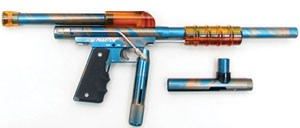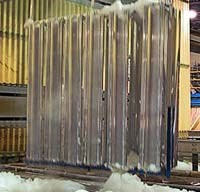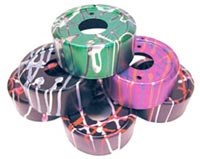Setting Targets
How one finisher is Meeting its Marks through Goal Setting and Dedication
Minneapolis, MN’s Hubert H. Humphrey Metrodome is the only stadium in the world to have hosted the NFL’s Super Bowl, major league baseball’s All-Star Game, two World Series and two NCAA Division I Men’s Basketball Championships. For thousands of Minnesotans, the Metrodome is hallowed ground.
For Pioneer Metal Finishing, now headquartered in Green Bay, WI, the Metrodome is where it all started. The company traces its roots to St. Paul Plating, a contract finishing shop whose building once stood on the land now occupied by the Metrodome.
From those simple beginnings a diversified industry giant has emerged. Pioneer now operates five plants (Green Bay and Oshkosh, WI; Minneapolis; Monroe, MI; and Portland, OR) and employed 800 people. The company provides anodizing, electroless nickel, chromate conversion coating, acid etching, passivation, painting, powder coating and E-coating services as well as a variety of trademarked specialty finishes.
CEO Bob Pyle, who joined the company as VP of Sales and Marketing in 1998, speaks proudly of Pioneer’s history and his reasons for joining the organization. “I loved what Pioneer stood for,” he says. “It was well-run, poised for growth and understood what customer service was
all about.”
Pyle’s pride also shows in his description of Pioneer’s current state. “We’re in a great position. Pioneer is number one in its markets, customer focused, and we work to provide the best service in this industry.”
Business Philosophy
According to Pyle, Pioneer’s business plan is all about growth. “We bought our Portland facility in March of 2006. In two-and-a-half years we tripled the physical size of the plant and tripled the business volume.”
Pyle gives customers the lion’s share of the credit for Pioneer’s business growth. “Our customers strongly encouraged us to get into business in the Pacific Northwest,” he explains. He also credits a response to market demand as the catalyst for Pioneer’s purchase of its Oshkosh division in December, 2007.
In the wake of two major acquisitions in the last three years, Pioneer has no intention of slowing down. Instead, its business goal is to acquire two businesses each year for the next several years. At the same time, Pyle believes in keeping a narrow focus with regard to the market space in which Pioneer participates. “We don’t want to be everything to everyone,” he says.
Pioneer also actively manages its company culture, which Pyle describes as high-energy and fast-paced, with a can-do attitude and a concentration on customer service. He regularly references his company’s core values: trust; serving customers; relational honesty and candor; always doing what’s important in the short term and the long term; and maximizing potential(ongoing development of people and teams).
According to Pyle, the unique requirements for success in the surface finishing industry drive the company’s culture. “What makes Pioneer unique is our focus on customer service, decision making and speed,” he says. “We believe if we do these things well, our customers will be happy when dealing with issues. The only way we can achieve these is to be candid and get things out on the table.”
Managing Satellite Facilities
Pioneer’s management system is centralized and decentralized at the same time. Pyle’s direct reports include the leaders of human resources, operations, sales and marketing, finance and research and development. While corporate management is centered in the company’s headquarters, Pioneer’s five satellite facilities are managed autonomously, with each plant having its own leader. The company gives wide latitude to the managers of its external locations.
Steve Salamone, operations manager for Pioneer’s Oshkosh Division, knows first-hand the challenges of balancing the need for effective on-site leadership with Pioneer’s larger corporate structure. Salamone, the Oshkosh plant management team and the division’s 80 employees have been working diligently to grow the facility and are having significant success, having tripling the revenue of the operation in just the last few months.
That growth has been driven by a handful of key customers. “They have been attracted by commitment to customer service,” Salamone says. He also believes customers have been reassured by the division’s actions when something doesn’t go quite right. “We make mistakes, but we are responsive to those mistakes and fix them. We are hearing extensively that this is something others in our industry don’t do. In this economic environment you keep your customers close and respond to them.”
Meshing the corporate culture of the recently acquired operation with the culture of the larger company is an ongoing process for Salamone. “We’re starting to align our culture with that of the company, but it’s hard to change old habits,” he says. “It’s easy to talk about it, but to instill it is another story. We lead by example, by the time we put in, and our basic practices of what we do around the plant and how we act.”
Salamone believes the key to building a strong team is to ensure that his people share a vision for the direction of the organization. He wants his team to treat the business as if they own it. He is also a strong believer in letting people make mistakes. “If you’re going to make a mistake, be able to back it up with a philosophy that says, ‘This is why I did it.’ Learn from the mistake as opposed to punishing the mistake,” he says.
Pyle agrees. “If the mistake is consistent with our values, that’s what is important. Failure’s a must in order to improve, It’s OK to fail, but make [the mistake] a little one.”
Leadership Development
With such a fast-paced, customer-oriented environment, one of Pyle greatest challenges is ensuring that he has the right team members to enable Pioneer to reach its goals. To that end, the company has placed development of future leaders near the top of its business priorities and has implemented a formal leadership development program.
The program is a passion for Pyle, who dedicates 50% of his time to it and the goal of filling the majority of open positions by promoting from within. “We find people who are candid, confident, create vision, and are compelling enough that people want to follow them,” he says.
Salamone’s criteria for team members dovetail with Pyle’s. “We want people that are open and communicate honestly, are willing to take a risk on being wrong and accept that if they’re wrong that’s OK. We want people who are willing to step out and disagree with the leader.”
The leadership program has two tracks: technical and management leadership. Criteria for program entrance are demanding. “We want this to be special,” says Pyle. “You have to fight to get in.”
The first requirement is that the candidate possess the skills and abilities to scale two levels vertically in the Pioneer leadership team. The second requirement is that, in the management team’s judgement, the candidate will be ready to step into a key top-tier position in the company in five to 10 years.
Pioneer launched the program by assessing interested associates and selecting eight individuals at various levels of the organization. Once admitted, participants were assigned a mentor in a position at least two management levels above and outside the participant’s reporting line. The participant and mentor meet biweekly to discuss business issues and the participant’s progress. The mentor provides a quarterly progress report to executive management, in which the participant is given an opportunity to include input.
Being admitted to the program is just the beginning. To remain in the program the participant must remain a top performer, attend every scheduled mentor meeting, and deliver on all commitments within the program. “If you commit, you commit,” Pyle says. The expectations are not just lip service. Two of eight candidates admitted into the program 18 months ago have since dropped out.
The development of a company leader is a rewarding process for Pyle, who says watching his team members grow is the most fulfilling part of his job. He cites Pioneer’s customer relations manager as an example. “She started at the age of 17 answering telephones and grew into a position of tremendous responsibility. It’s just great.”
Measuring Performance
As a company driven by performance and results—and one that places such a premium on maximizing its potential—
gauging the effectiveness of the program is important to Pioneer.
2009 is shaping up as a challenging year for any company serving the manufacturing sector, and these challenges will complicate the process of measuring managerial performance. With the world economy in decline and some metrics showing manufacturing volume off by 20% or more, traditional performance measurements like gross margin, net income or cash flow may not tell the whole story.
Consequently, measuring effectiveness is something Pyle wrestles with. “The bottom line is results, but we also look at how participants behave,” he explains.
Pioneer uses a 360° review program to evaluate its leaders against business objectives and expected behaviors. A concept that has gained momentum in the last decade, a 360° review program expands an employee’s performance evaluation well beyond an assessment by his or her immediate supervisor. Instead, input can be solicited from multiple individuals with whom the person being reviewed relates.
Reviewers can include co-workers, subordinates and supervisors as well as outside contacts with whom the individual interacts, such as customers or suppliers. The benefits of such a program include providing a broader and better-rounded source of performance feedback, more accurate analysis of an individual’s strengths and a more effective identification of personal growth and development opportunities for the person being reviewed.
Pyle is free with advice for finishers contemplating a leadership development program of their own. “First, I wouldn’t do it if you’re not committed. It all comes down to time and money. If you don’t commit both your people will know it’s just the flavor of the day—it’s just window dressing.”
Despite the obvious commitment, Pyle is withholding judgment on the effectiveness of the program. “Ask me in a year-and-a-half,” he says with a smile. Turning a bit more serious, he says, “We’ve learned a lot and developed good people so far.”
Related Content
ECOAT24 Issues Call for Speakers
Don't miss your chance to apply to speak at ECOAT24. Submit your abstract by June 26, 2023.
Read MoreConveyors and Paint Systems
Choosing the right conveyor system, coating technology, and ancillary equipment.
Read MoreAn Altruistic Growth Strategy Puts People First
Professional Plating emphasizes investing in its team and fostering a supportive environment on the shop floor.
Read MoreTop Shop Leader Focuses on Its People as Key to Success
Twin Cities job shop, Avtec, was named a Top Shop for the third time in 2022, due in no small part to its commitment not only to the work it produces but to those who produce it — its employees.
Read MoreRead Next
Delivering Increased Benefits to Greenhouse Films
Baystar's Borstar technology is helping customers deliver better, more reliable production methods to greenhouse agriculture.
Read MoreA ‘Clean’ Agenda Offers Unique Presentations in Chicago
The 2024 Parts Cleaning Conference, co-located with the International Manufacturing Technology Show, includes presentations by several speakers who are new to the conference and topics that have not been covered in past editions of this event.
Read MoreEpisode 45: An Interview with Chandler Mancuso, MacDermid Envio Solutions
Chandler Mancuso, technical director with MacDermid Envio discusses updating your wastewater treatment system and implementing materials recycling solutions to increase efficiencies, control costs and reduce environmental impact.
Read More






















.jpg;maxWidth=300;quality=90)







